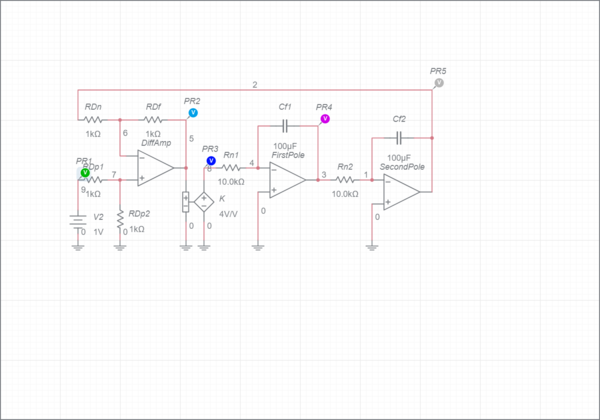Difference between revisions of "User:DukeEgr93/Lab 7"
(Created page with "This page provides guidance for Labs 6 and 7 for Controls in Summer 2020. It assumes knowledge of SISOtool and Root Locus design as given by User:DukeEgr93/RL Example and...") |
(→Building The Plants) |
||
| Line 5: | Line 5: | ||
== Building The Plants == | == Building The Plants == | ||
| − | The plants for this lab will be second plants with two poles and no zeros. The first plant will be marginally stable with poles at $$\pm j2$$ and the second will be unstable with poles at $$\pm 2$$ | + | The plants for this lab will be second plants with two poles and no zeros. The first plant will be marginally stable with poles at $$\pm j2$$ and the second will be unstable with poles at $$\pm 2$$. The gain in each case will be 4, meaning: |
<center><math> | <center><math> | ||
| − | + | \begin{align*} | |
G_1&=\frac{4}{s^2+4} & G_2&=\frac{-4}{s^2-4} | G_1&=\frac{4}{s^2+4} & G_2&=\frac{-4}{s^2-4} | ||
\end{align*} | \end{align*} | ||
</math></center> | </math></center> | ||
| − | These transfer functions are easy enough to simulate in MATLAB, but you will also be building circuits to simulate them. Unstable circuits generally require some kind of amplification and some kind of feedback. For this lab, the plant will consist of two pure integrators cascaded together (creating a double pole at the origin) along with a difference amplifier (to provide a feedback loop and | + | These transfer functions are easy enough to simulate in MATLAB, but you will also be building circuits to simulate them. Unstable circuits generally require some kind of amplification and some kind of feedback. For this lab, the plant will consist of two pure integrators cascaded together (creating a double pole at the origin) along with a difference amplifier (to provide a feedback loop) and a voltage controlled voltage source to adjust the value of $$K$$. Build the following in multisim: |
| + | [[File:TwoPolePlantGain.PNG|600px]] | ||
| + | |||
| + | For the capacitors, select each and set their initial conditions to 0 through the Item dialog block (click on a capacitor, then click on the gear at top right if the Item block is not open). For the document, select the Initial conditions section and change the dropdown box to User defined. Set the transient to graph for 5 seconds. | ||
| + | * '''With the gain set to 4 V/V, make a graph with the five probed signals. Save this graph and rename it StepResponse1.''' | ||
| + | * ''' With the gain set to -4 V/V, make a graph with the five probed signals. Save this graph and rename it StepResponse2.''' | ||
| + | * ''Confirm for yourself that the first response is typical of a marginally stable system with a frequency of 2 rad/s and the second response is typical of an unstable system (until the om-amp voltages saturate at 12V for the Probe 4 and 5 readings. | ||
Revision as of 19:04, 30 July 2020
This page provides guidance for Labs 6 and 7 for Controls in Summer 2020. It assumes knowledge of SISOtool and Root Locus design as given by User:DukeEgr93/RL Example and Chapter 9 of Nise 8e.
Introduction
For this part of the lab, you will end up designing and simulating a PD controller for a marginally stable plant and a lead controller for an inherently unstable plant. The plants themselves will be built using passive elements and operational amplifiers. In your report, you will be discussing how well your designs satisfy the criteria given for the system based on both the mathematically simulated results and the circuit simulations.
Building The Plants
The plants for this lab will be second plants with two poles and no zeros. The first plant will be marginally stable with poles at $$\pm j2$$ and the second will be unstable with poles at $$\pm 2$$. The gain in each case will be 4, meaning:
These transfer functions are easy enough to simulate in MATLAB, but you will also be building circuits to simulate them. Unstable circuits generally require some kind of amplification and some kind of feedback. For this lab, the plant will consist of two pure integrators cascaded together (creating a double pole at the origin) along with a difference amplifier (to provide a feedback loop) and a voltage controlled voltage source to adjust the value of $$K$$. Build the following in multisim:

For the capacitors, select each and set their initial conditions to 0 through the Item dialog block (click on a capacitor, then click on the gear at top right if the Item block is not open). For the document, select the Initial conditions section and change the dropdown box to User defined. Set the transient to graph for 5 seconds.
- With the gain set to 4 V/V, make a graph with the five probed signals. Save this graph and rename it StepResponse1.
- With the gain set to -4 V/V, make a graph with the five probed signals. Save this graph and rename it StepResponse2.
- Confirm for yourself that the first response is typical of a marginally stable system with a frequency of 2 rad/s and the second response is typical of an unstable system (until the om-amp voltages saturate at 12V for the Probe 4 and 5 readings.